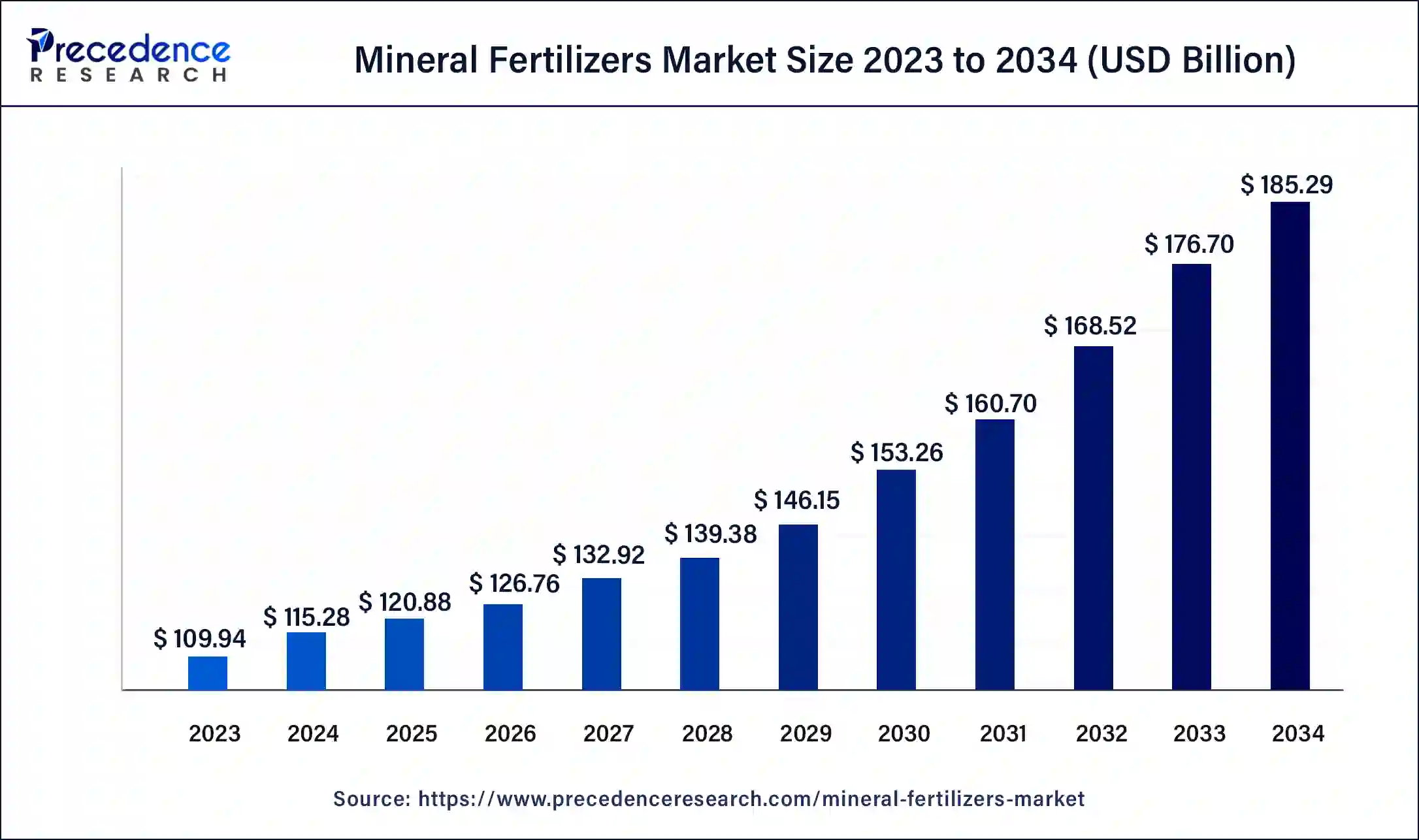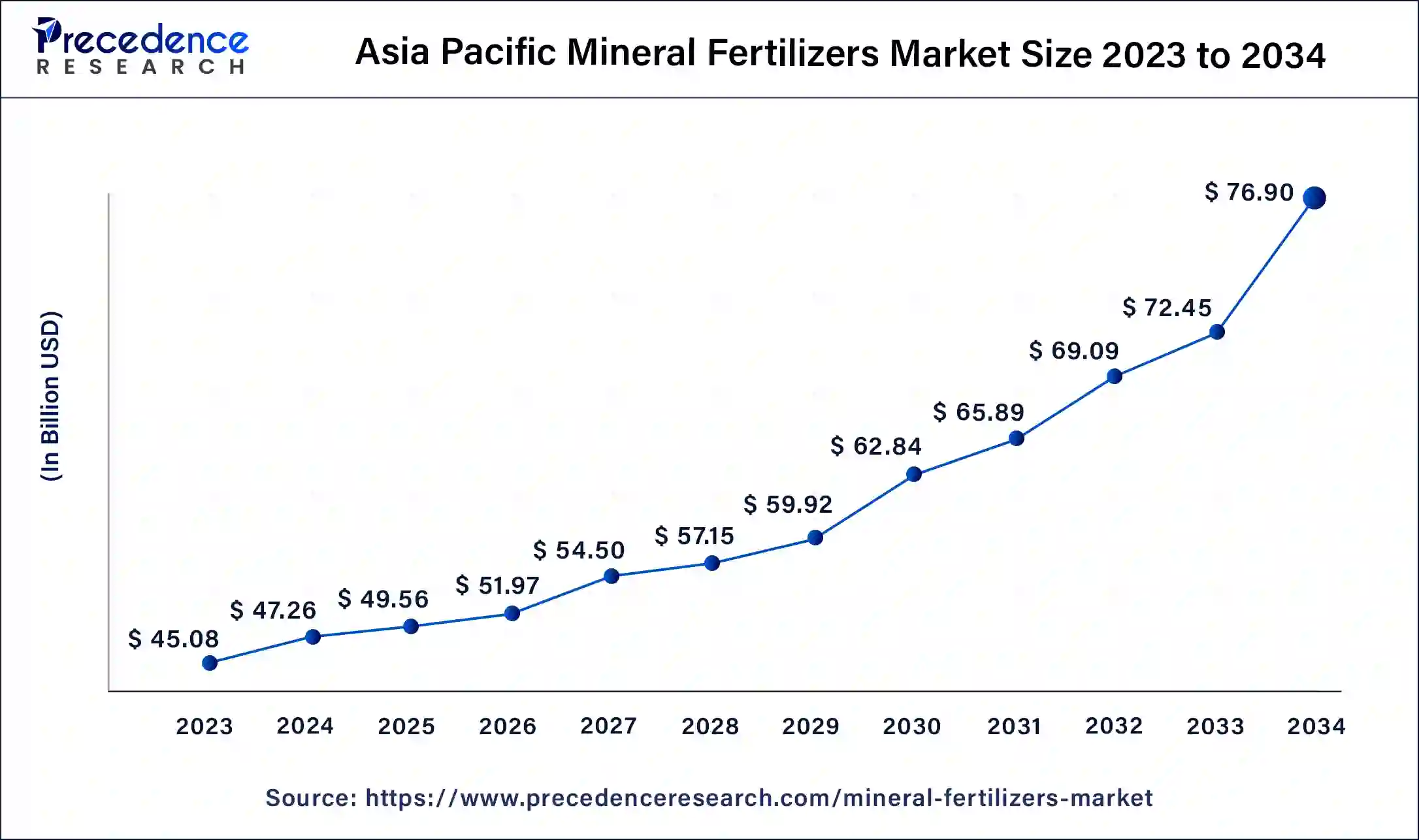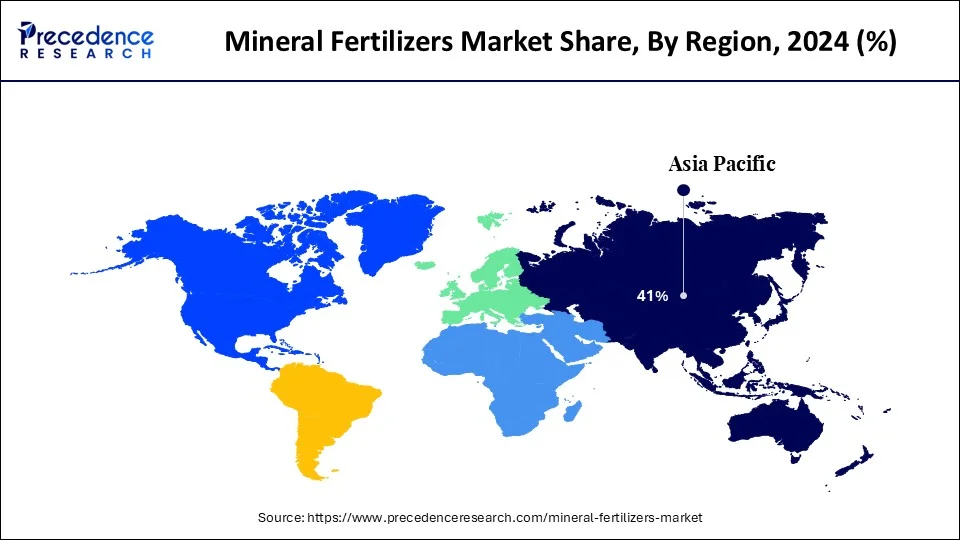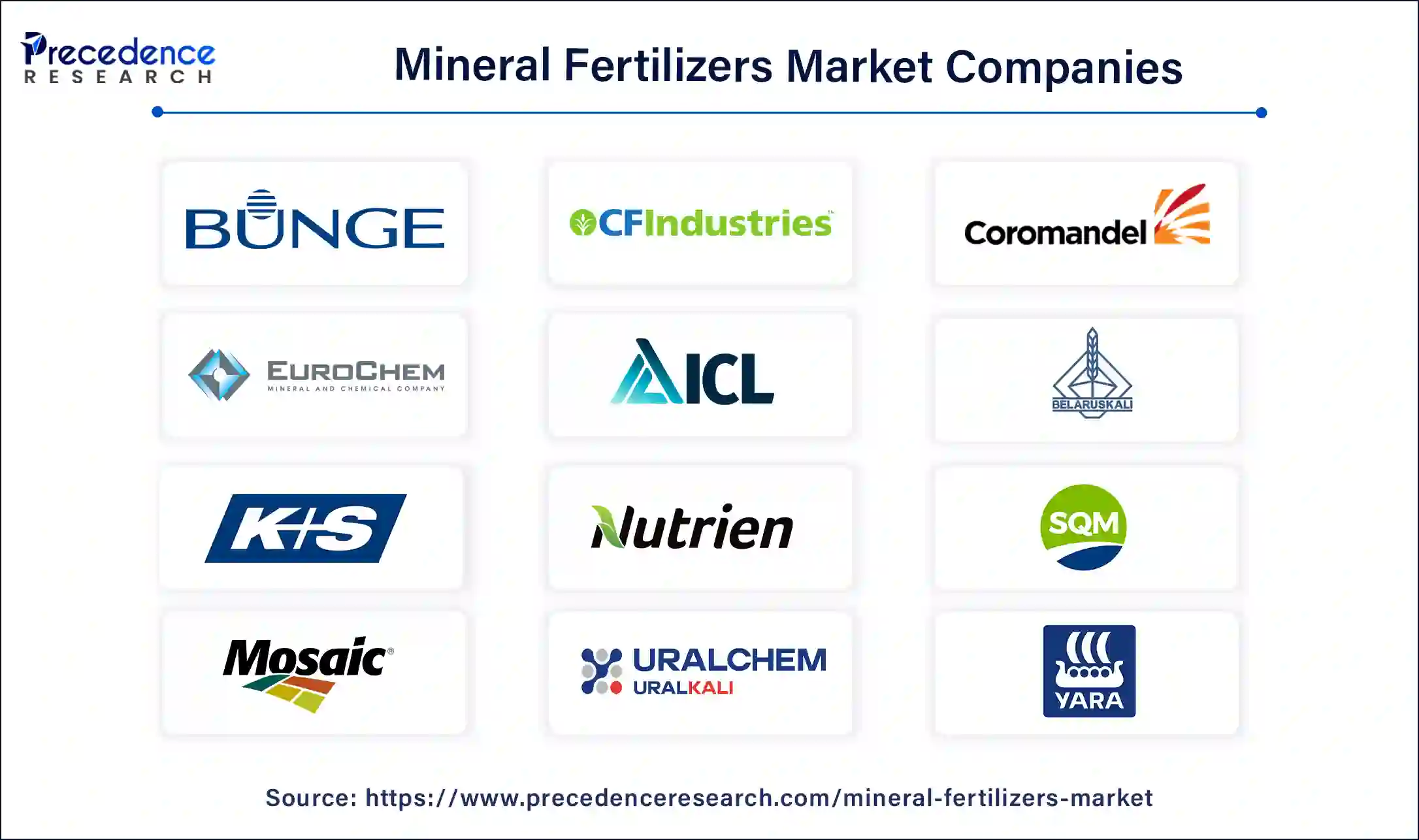List of Contents
Mineral Fertilizers Market Size and Forecast 2025 to 2034
The global mineral fertilizers market size was valued at USD 115.28 billion in 2024 and is expected to reach around USD 185.29 billion by 2034, growing at a solid CAGR of 4.86% over the forecast period 2025 to 2034. The major factors driving the mineral fertilizers market are growth in emerging markets, a low-interest environment, and government support.

Mineral Fertilizers Market Key Takeaways
- The global mineral fertilizers market was valued at USD 115.28 billion in 2024.
- It is projected to reach USD 185.29 billion by 2034.
- The mineral fertilizers market is expected to grow at a CAGR of 4.86% from 2025 to 2034.
- Asia Pacific dominated the mineral fertilizers market with the largest market share of 41% in 2024.
- North America is anticipated to witness the fastest growth in the market over the period studied.
- By nutrient type, the potash-based fertilizers segment dominated the market in 2024.
- By nutrient type, the nitrogen-based fertilizer segment is expected to show the fastest growth in the market over the forecast period.
- By crop type, in 2024, the oilseed segment dominated the global market.
- By crop type, the cereals segment is expected to grow at the fastest rate in the market over the projected Period.
- By application, the foliar spray segment led the market in 2024.
- By application, the fertigation segment is expected to show the fastest growth in the market over the forecast period.
Asia Pacific Mineral Fertilizers Market Size and Growth 2025 to 2034
The Asia Pacific mineral fertilizers market size was exhibited at USD 47.26 billion in 2024 and is projected to be worth around USD 76.90 billion by 2034, poised to grow at a CAGR of 4.99% from 2025 to 2034.

Asia Pacific dominated the mineral fertilizers market in 2024. Asian countries such as Korea, Japan, China, and Vietnam are utilizing high nitrogen fertilizer levels per hectare for both perennial and short-term crops. Among these nations, China is anticipated to lead the market, with a projected market share. This dominance is mainly due to the rising demand for agricultural products in the region, which is propelling the growth of the mineral fertilizers market.

North America is anticipated to witness the fastest growth in the mineral fertilizers market over the period studied. The United States fertilizer industry is influenced by numerous factors, including the presence of advanced agricultural practices and the increasing adoption of technology within the sector. Crop demand and output requirements, which may be influenced by local government regulations and subsidies, play a significant role. Additionally, producers' fertilizer purchasing decisions are impacted by global price fluctuations, particularly for crops like maize and soybeans. The growing implementation of precision agricultural technologies is also driving the demand for fertilizers in the country and the region.
- In June 2023, ICL, a global leader in specialized minerals, announced the North American introduction of a new line of innovative foliar and fertigation solutions under the Nova brand of water-soluble fertilizers. The flagship products are Nova FINISH™, Nova PULSE™, Nova ELEVATE™, and Nova FLOW™.
Market Overview
Mineral fertilizers are inorganic compounds, primarily salts, that supply essential nutrients to plants. Both the soil and plants can be negatively impacted by mineral fertilizers. These fertilizers undergo various transformations within the soil, affecting their permeability, nutrient solubility, and availability to plants. Chemically processed to meet crop requirements, mineral fertilizers can deliver nutrients to plants in precise, scientifically determined quantities.
Mineral fertilizers contain nutrient levels far exceeding those of organic fertilizers and are the most efficient means of improving crop quality and yield when applied properly. The number of mineral fertilizers applied per hectare is a key measure of agricultural productivity, particularly in crop cultivation, which is the most vital sector of agriculture.
- According to Ukraine's Ministry of Agrarian Policy and Food. Ukraine produced almost 2 million Tonnes of mineral fertilizers in 2023. It is noted that the total production potential in Ukraine is up to 3 million tonnes of fertilizers per year. At the same time, the fertilizer industry has a significant export potential. Therefore, the ministry plans to expand export markets, including in EU countries.
Mineral Fertilizers Market Growth Factors
- Rising government subsidies and implementation policies are expected to drive the growth of the mineral fertilizers market.
- Growing awareness among farmers about the benefits of mineral fertilizers can fuel the growth of the mineral fertilizers market further.
- Advancements in technology, along with innovative product formulations, can boost the mineral fertilizers market growth shortly.
Mineral Fertilizers Market Scope
| Report Coverage | Details |
| Market Size by 2034 | USD 185.29 Billion |
| Market Size in 2025 | USD 120.88 Billion |
| Market Size in 2024 | USD 115.28 Billion |
| Market Growth Rate from 2025 to 2034 | CAGR of 4.86% |
| Largest Market | Asia Pacific |
| Base Year | 2024 |
| Forecast Period | 2025 to 2034 |
| Segments Covered | Nutrient Type, Crop Type, Application, and Regions |
| Regions Covered | North America, Europe, Asia-Pacific, Latin America, and Middle East & Africa |
Market Dynamics
Driver
Growing demand for nutrient-dense fertilizers
Mineral fertilizers are rich in nutrients and provide essential nourishment to a variety of crops. These fertilizers are made up of organic materials, including animal manure, agricultural waste, or sewage sludge, combined with minerals. The organic matter in organo-mineral fertilizers helps shield the inorganic elements through adsorption, thus slowing the release of nutrients to plants.
Additionally, mineral fertilizers contribute to higher crop yields by enhancing crop productivity and increasing the plants' water retention capacity. This is achieved by reducing nutrient leaching losses. The detrimental effects of other fertilizers caused by prolonged chemical exposure may further drive the mineral fertilizers market.
- In February 2024, The Union Cabinet of India approved the proposal of the Department of Fertilizers for fixing the Nutrient Subsidy (NBS) rates for KHARIF Season 2024 on phosphatic and potassic (P&K) fertilizers and the inclusion of 3 new fertilizer grades under the NBS scheme. The tentative budgetary requirement for Kharif season 2024 would be approximately Rs.24,420 crore.
Restraint
Raw material availability and cost
The fertilizer industry is currently encountering substantial challenges related to the availability and fluctuating costs of raw materials needed for fertilizer production. The primary cause of price volatility is the imbalance between supply and demand. However, Nations such as India are particularly disadvantaged due to a scarcity of natural resources essential for fertilizer manufacturing. These factors can hamper the mineral fertilizers market growth.
Opportunity
Utilization of high-efficacy fertilizers
High-efficiency fertilizers are increasingly gaining traction in the mineral fertilizers market, marking a notable trend. Environmental concerns such as nutrient runoff and greenhouse gas emissions are driving the adoption of sustainable agriculture practices and precision agriculture. These factors present potential market opportunities for the future.
The agriculture industry is witnessing a surge in demand driven by the growing global population and the need for improved food security. Higher agricultural output is necessary to meet this increased food production requirement, boosting the demand for nitrogen-based fertilizers, phosphates, and potash. This trend is particularly significant in developing economies and expanding agricultural sectors.
- In January 2024, CSIR launched a tech-driven initiative to improve productivity and farmers' income. The project envisages the use of IoT-based sensors and drone-based hyper and multi-spectral imaging to generate a real-time precision database to develop knowledge of phenological and physiological indicators as influenced by the micro-environment of various target crops being grown across different agro-climatic conditions.
Nutrient Type Insights
The potash-based fertilizers segment dominated the mineral fertilizers market in 2024. This can be attributed to the maturation of plants by improving their health, root strength, disease resistance, and yield rates. Advanced fertilizers, such as nitrogen-based fertilizers, phosphates, and potash, are vital for boosting crop yield and maintaining soil nutrients. These essential minerals are in high demand among developing economies and agricultural sectors. Additionally, maintaining an adequate supply of potassium in the soil is important for promoting healthy and nutritious plant growth.
The nitrogen-based fertilizer segment is expected to show the fastest growth in the mineral fertilizers market over the forecast period. Nitrogen plays a vital role in plant growth and reproduction, with pasture and crop growth frequently benefiting from increased soil nitrogen availability. This is often managed by adding nitrogen fertilizers, which primarily promote leafy growth in plants. The nitrogenous fertilizer industry also involves the production of synthetic ammonia, nitric acid, ammonium nitrate, and urea. Synthetic ammonia and nitric acid mainly serve as intermediates in producing ammonium nitrate and urea fertilizers.
Crop Type Insights
The oilseed segment dominated the global mineral fertilizers market in 2024. Oilseeds are primarily grown for the extraction of edible oils. These seeds are a significant source of oils for human consumption, and they're by-products for animal feed. Major oilseeds include rapeseed, peanut, soybean, and cottonseed. However, the productivity of oilseeds is often hampered by the lack of advanced technologies, cultivation under resource-limited conditions, and challenges created by biotic and abiotic stresses.
The cereals segment is expected to grow at the fastest rate in the mineral fertilizers market over the projected Period. Seed wheat (or other cereal seeds) should be true to its specific variety and as free as possible from foreign seeds. Moreover, the surge in at-home breakfast eating and the renewed popularity of cereals for breakfast have driven consumer demand. While taste has traditionally been the top priority for consumers when choosing breakfast cereals, the pandemic has led to an increased focus on health, which can propel the segment's growth.
The table shows the countries with the largest production of cereals in 2020
| Rank | Country/Region | Cereal Production (Tonnes) |
| 1. | People's Republic of China | 615,518,145 |
| 2. | United States | 434,875,197 |
| 3. | India | 335,035,000 |
| 4. | Russia | 130,037,708 |
| 5. | Brazil | 125,568,280 |
| 6. | Argentina | 86,573,396 |
| 7. | Indonesia | 77,149,202 |
| 8. | Canada | 65,013,700 |
| 9. | Ukraine | 64,342,357 |
| 10. | Bangladesh | 59,960,399 |
Application Insights
The foliar spray segment led the mineral fertilizers market in 2024. Foliar spraying involves directly applying nutrients, boosters, or pesticides to a plant's leaves and stems. The liquid material is absorbed through the plant's pores, known as stomata, as well as through the epidermis. While foliar spraying is effective for building plant health in the short term, it should complement a long-term soil-building program. Although nothing can replace soil feeding, foliar applications can be beneficial at certain times of the year or as a temporary solution for nutrient deficiencies until the soil can adequately supply them.
- In June 2024, UMass Amherst launched a beech leaf disease control effort with tree spraying on campus for beech leaf disease (BLD), a rapidly spreading complex associated with the foliar nematode Litylenchus crenatae. The disease causes damage to a tree's leaves, leading to reduced vigor, and can eventually lead to tree mortality. The disease has been particularly damaging in Southern New England, where many trees die rapidly after infection.
The fertigation segment is expected to show the fastest growth in the mineral fertilizers market over the forecast period. Fertigation is an agricultural technique that involves applying water and fertilizer together through irrigation, and this method helps maximize yield while minimizing pollution. Moreover, fertigation allows farmers to distribute nutrients uniformly across their fields as needed. It is commonly used for row crops, horticultural crops, fruit crops, vegetable crops, and ornamental and flowering crops.
Mineral Fertilizers Market Companies

- Bunge Ltd.
- CF Industries Holdings Inc.
- Coromandel International Ltd.
- Eurochem Inc.
- Israel Chemicals Ltd
- JSC Belaruskali
- K+S KALI GmbH
- Nutrien Ltd.
- Sinofert Holdings Ltd.
- SQM
- The Mosaic Company
- Uralkali PJSC
- Yara International ASA
Recent Developments
- In 2023, acute food insecurity levels reached record highs due to prolonged food crises and new shocks. Approximately 238 million people across 48 countries are facing severe food insecurity, which is 10% higher than in 2022.
- In December 2023, Koch Ag & Energy Solutions (KAES), a global provider of agricultural, energy, and chemical solutions, announced that it had reached an agreement to buy OCI Global's fertilizer facility in Wever, Iowa, for $3.6 billion.
- In January 2022, Ÿnsect, a certified B Corp company, and world leader in producing insect-based ingredients, announced the launch of ŸNFABRE, the first industrial genomic selection program applied to mass insect farming.
Segments Covered in the Reports
By Nutrient Type
- Nitrogen
- Phosphate
- Potash
- Other
By Crop Type
- Cereals
- Oilseeds
- Vegetables
- Fruits
- Other
By Application
- Foliar Spray
- Fertigation
- Drop Spreading/Placement
- Broadcasting
By Geography
- North America
- Asia Pacific
- Europe
- Latin America
- Middle East & Africa
For inquiries regarding discounts, bulk purchases, or customization requests, please contact us at sales@precedenceresearch.com
Frequently Asked Questions
Ask For Sample
No cookie-cutter, only authentic analysis – take the 1st step to become a Precedence Research client